Janus facts for kids
Quick facts for kids JanusIANVS |
|
|---|---|
 |
|
| Etruscan equivalent | Culśanś |
Janus was a special god in Roman mythology. He was known for having two faces! This helped him look to the past and the future at the same time. He was the god of beginnings and endings. This also made him the god of gates, doors, and passages.
The Romans even named the month of January after him. Think about it: in January, we look back at the old year and forward to the new one. Janus also watched over war and peace. When Rome was at war, the doors of his temple were open. When there was peace, they were closed. He was also important for journeys, trade, and shipping. Interestingly, the ancient Greeks did not have a god like Janus.
Contents
The Story of Janus
Many Romans believed Janus was the first king of Latium. Latium was an ancient region in Italy. Sometimes, he was said to rule with a goddess named Camese. A legend says he welcomed the god Saturn. Saturn had been kicked out of Heaven by Jupiter. He arrived by ship at a place called Janiculum.
Another story tells how Janus helped the Romans. The Sabines, led by King Titus Tatius, attacked Rome. They wanted to get back their daughters, who the Romans had taken. Janus made a spring's cold water turn boiling hot. This helped the Romans fight off the Sabines.
Janus's Temple and Peace
King Numa Pompilius was said to have built a special temple for Janus. It was called Janus Geminus. During Numa's reign, the temple doors were always shut. This was because there were no wars. After Numa, the doors were closed only a few times.
They were closed after the first Punic War. They were also closed three times when Augustus was emperor. Emperor Nero closed them once too. It is recorded that Emperor Gordianus III opened the Janus Geminus. This meant Rome was going to war again.
Symbols of Janus
Janus was the protector of doors, gates, and roads. His two main symbols show this. They were a key and a staff. The key also meant that a traveler had arrived safely. It showed they came to a harbor or river crossing in peace. This was often to trade goods.
Janus: God of Change
Janus often stood for change and new beginnings. He represented the journey from the past to the future. He also symbolized moving from one situation to another. This included young people growing into adults.
He represented time itself. With one face, he could see into the past. With the other, he could see into the future. People honored Janus at the start of harvests and planting times. He was also important at weddings, deaths, and other new beginnings. He stood for the space between wild nature and cities. He also represented the journey from youth to adulthood.
Rites and Celebrations
Many special ceremonies honored Janus. He was celebrated at the start of every new year. He was also honored at the beginning of each month. There were also special times for the military season. These were in March, when fighting began, and October, when it ended.
Any religious act or ceremony usually started by calling on Janus first. This showed his importance for all beginnings.
New Year's Day Customs
The winter solstice was thought to be on December 25th. January 1st was New Year's Day. This day was special for Janus. It was the first day of the new year and the first day of the month of Janus. On this day, people would wish each other well.
Everyone would spend a short time on their usual work. They would also exchange gifts like dates, figs, and honey. These were signs of good wishes. They also gave coins called strenae. Cakes made of spelt (a type of grain) and salt were offered to Janus. These were burned on his altar. In ancient times, people offered grain and salt instead of animal sacrifices.
Images for kids
-
The temple of Janus with closed doors, on a coin from Nero's time.
-
The "Temple of Janus" at Autun, France.
See also
 In Spanish: Jano para niños
In Spanish: Jano para niños






